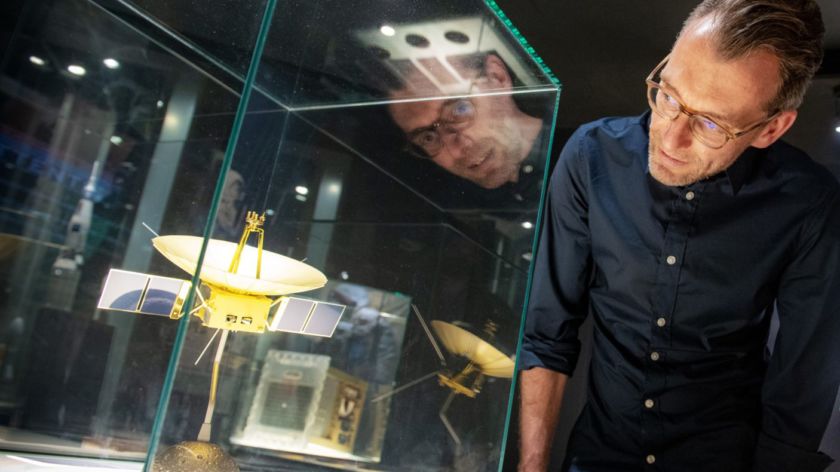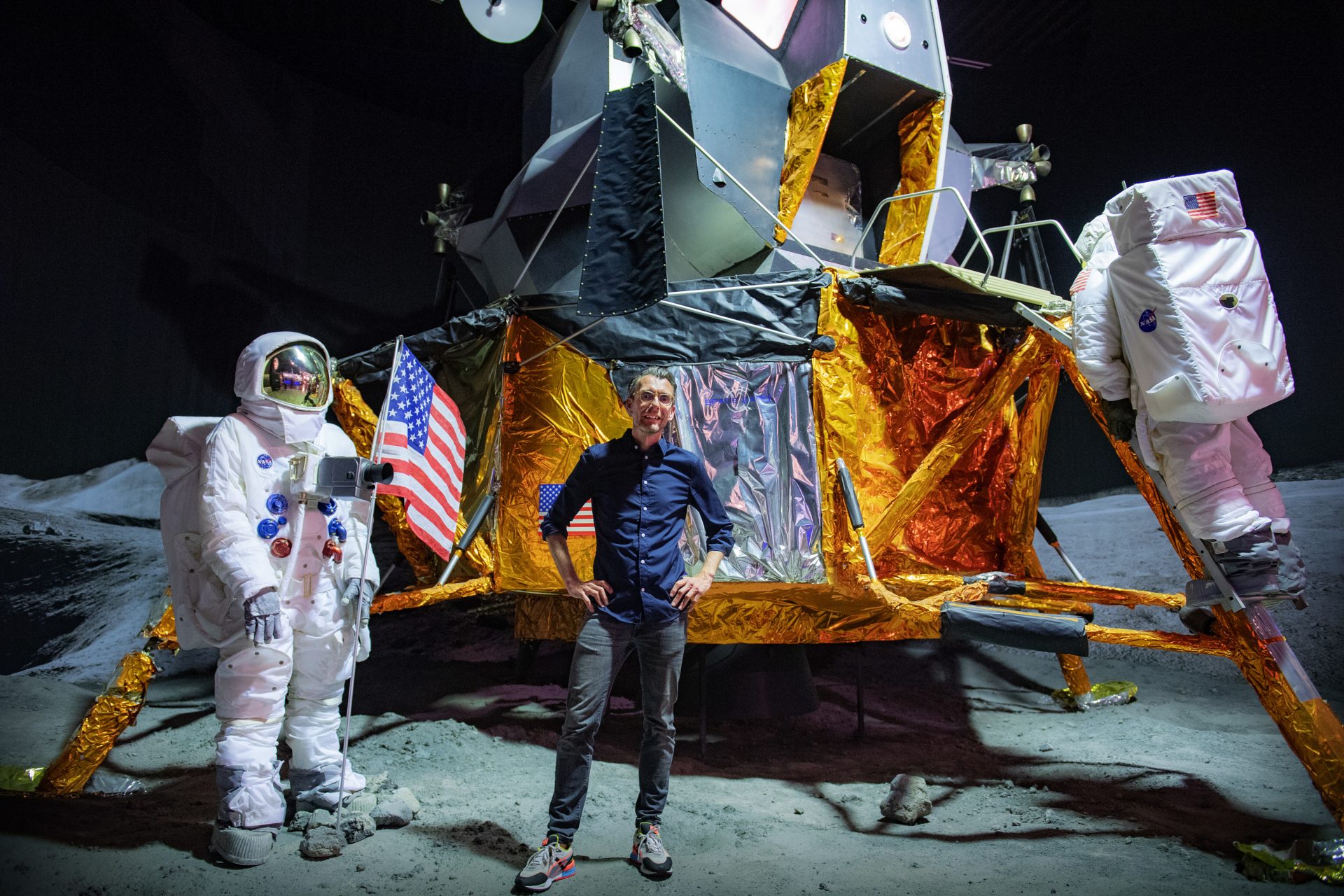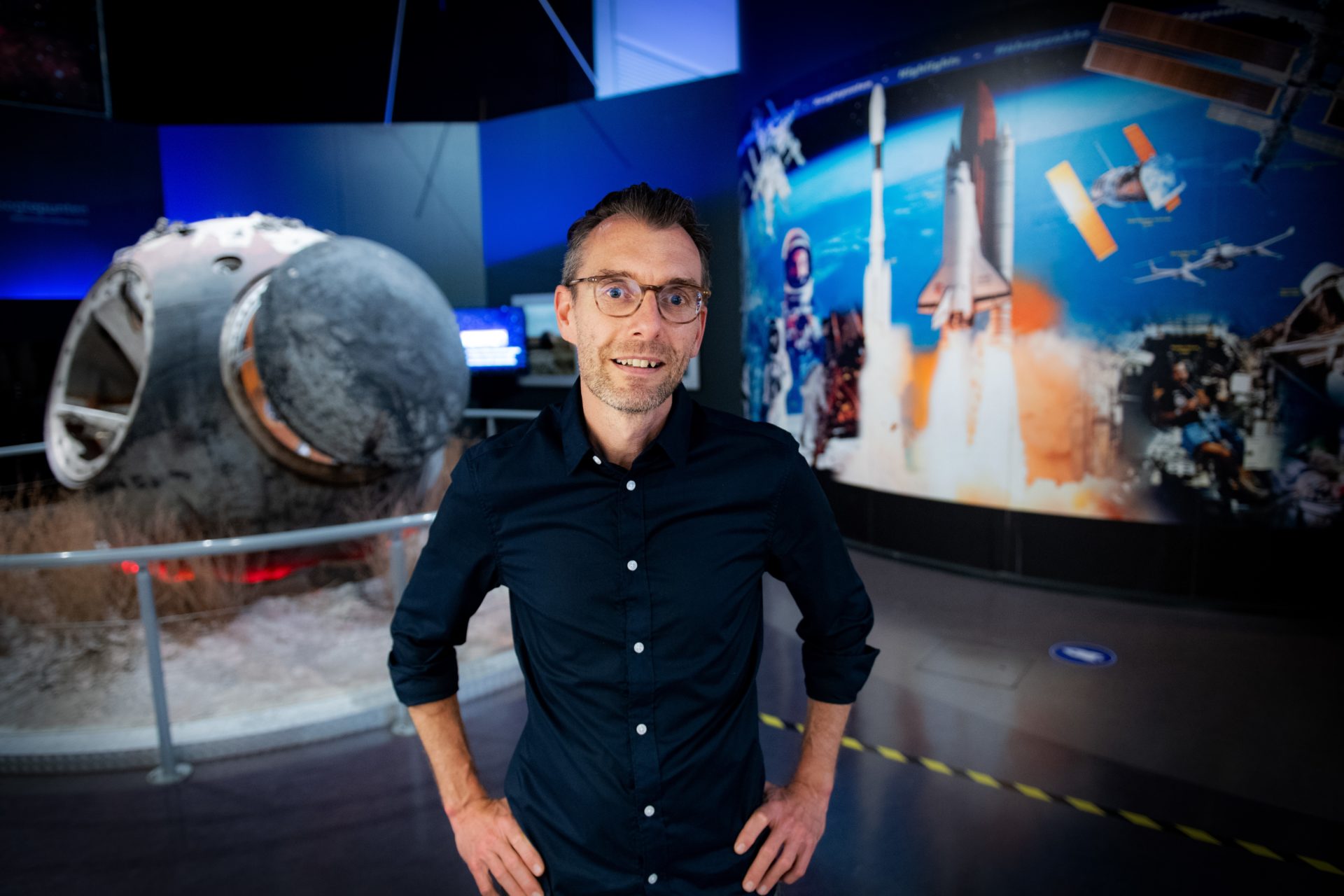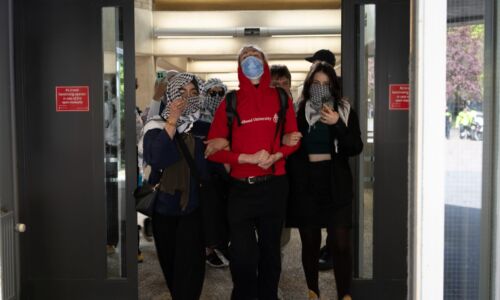Summer interview (5): astronomer Marc Klein Wolt has big dreams
-
 A miniature version of the Chinese Queqiao satellite containing Marc Klein Wolt's telescope. The astronomer loaned it to the ESTEC space center in Noordwijk. Photo: Bert Beelen
A miniature version of the Chinese Queqiao satellite containing Marc Klein Wolt's telescope. The astronomer loaned it to the ESTEC space center in Noordwijk. Photo: Bert Beelen
He has already managed to get a telescope to hitch a ride on a Chinese satellite to the moon, but astronomer Marc Klein Wolt’s plans go even further. He would like to set up an entire network of telescopes on the back of the moon, and another one on top of a mountain in Namibia. He has no lack of ambition, but those around him sometimes have trouble keeping up with him.
At 5:30 in the morning of 21 May 2018, a thin, white rocket detaches from a launching platform at a military base in southern China. With a thundering roar, it slowly fades out of sight as it flies towards the east. Final destination: a place 64,500 kilometres behind the moon. There, the communication satellite Queqiao that has been carried on board is to orbit behind the grey celestial body.
The launch is the finest hour of the Radboud astronomer Marc Klein Wolt (47). This is because a telescope from his own Radboud Radio Lab is attached to the Chinese satellite. The telescope—actually, a radio antenna—is able to detect the very oldest signals of the universe, sent immediately after the big bang: the birth of the universe. Although these signals cannot be observed on Earth, behind the moon, more than 440,000 kilometres from Earth, it is perfectly possible.
That the astronomer from the Huygens building finally managed to get the antenna there could be regarded as a small miracle. It was a nearly impossible route, full of setbacks, along roads running counter to all conventional collaborations in international space travel and astronomy. For example, the astronomer did not contact the Chinese until after the European Space Agency (ESA) had said that it saw no potential in Klein Wolt’s idea of an antenna behind the moon. Although the Chinese space organisation was initially enthusiastic, it waited until the very last minute to approve the Netherlands-China Low-Frequency Explorer (NCLE) antenna.
The Chinese satellite project is typical of Klein Wolt. ‘Shoot for the moon. Even if you miss, you’ll land among the stars’. The famous quotation of Norman Vincent Peale, the author of The power of positive thinking (1953), could easily have been the motto for his life. The astronomer is a vessel filled with great ambitions. For the ESA, he is currently working on a radio telescope that will be placed on the moon, and he is trying to move another telescope from Chile to Namibia. In the meantime, he also arranged for four respirators from Radboudumc to help his colleagues in Windhoek. ‘For many challenges I think: it’s impossible, so we have to do it’.
He radiates energy as we talk with each other on a terrace in Nijmegen East. Klein Wolt appears in tip-top shape: a snow-white shirt, trainers on his feet and his hair combed back. He speaks quickly, enthusiastically and at length, often alternating with a striking, infectious smile. Halfway through the interview, he rings his secretary to say that he will be a little late for his next appointment.
Putting a telescope on the moon does indeed seem impossible.
He immediately starts to laugh. ‘Maybe that’s why the ESA asked me to be the project leader. With the China project, we truly put our Radio Lab on the map. A telescope on the back of the moon—radio astronomers have been dreaming about that for decades. In technical terms, however, it’s extremely complicated. Everyone thinks you’re crazy. So I’m just going to do it. Well, of course, there’s a whole team behind it. As the project leader, I just happen to be the face to the outside world. For example, Heino (Falcke, ed.) and astronomy professor Leon Koopmans from Groningen are also involved’.
The radio telescope that will be put on the moon consists of a network of hundreds of small antennae, each about a metre in size. They all pick up radio signals, which together should form a single image, like the composite eye of a bee. Klein Wolt’s single antenna on the Chinese Queqiao satellite pales in comparison.
The lunar telescope can look back 13 billion years in time.
A comparable system—LOFAR—exists in Drenthe, but its cosmic big sister has the potential to make much better observations, unimpeded by the Earth’s atmosphere and all of the radio signals that we transmit day in, day out with our telephones and other devices. As a result, the lunar telescope will soon be able to look extremely far back in time, to signals 13 billion light-years away that are just as many years old. During the ‘Dark Ages’ of the universe, there weren’t any stars yet, so there was no light. However, radiation was already being emitted and it can teach us about what happened during the birth of our universe.
Is it a matter of copying the system in Drenthe and pasting it on the moon?
‘There’s so much more involved in the lunar telescope—mainly practical matters. For example, because space is limited on an ESA rocket, the rocket builders want to know how much these things weigh. And whether they can be collapsed. In addition: How are they going to be installed once they get there? Are we going to land on the moon first, and then use a robot to put them in exactly the right place? Or could we drop them on the ground with less precision while the lander flies over the surface? We continuously have to make such trade-offs between practical feasibility and precision’.
When will they be in place?
He starts calculating out loud. ‘The ESA would like to send a mission to the moon every two or three years. We hope to send the first antenna along as soon as 2026. Four to six years later, we would take around a thousand to the back of the moon. That’s extremely fast in terms of space travel. Actually, too fast. It’s weird, after all those years. Sometimes we just have to pinch ourselves. Are we really doing this now? It’s a dream come true’.
New race to space For the past few years, the moon has been the centre of attention for all global powers. You could even say there’s a real new race to space, just like in the 1960s, when the USA and the Soviet Union wanted to be the first to send a human being to our cosmic neighbour. Now, NASA once again has plans for staffed lunar missions. For example, they would like to put a station—the Lunar Gateway—into orbit around the celestial body in late 2024 and, later, they hope to establish a base on the lunar surface. They might do this in collaboration with the European ESA, who also have their own ambitions, like Klein Wolt’s antenna project. Russia would also like to build a lunar base—on the South Pole—but in collaboration with China. The latter country already put a cart on the moon (which also accompanied ‘Klein Wolt’s’ rocket in 2018), and they added another lander this spring. Many countries ultimately hope to use the moon as a springboard for missions to Mars.
The project involving the Chinese lunar mission actually went too fast as well, notes Klein Wolt in the podcast De man en de maan [The man and the moon] (NTR, 2020). For this prize-winning series, the journalist Saar Slegers followed the astronomer throughout his entire China adventure. He frequently had to go to Asia to take care of things, often unexpectedly. This put a strain on his family, particularly when his daughter was having trouble at school.
You kept going, despite the situation at home.
‘I was talking about that again with my wife just this morning. She said that she had felt quite lonely at times. It was such an intense period. That was indeed quite difficult to hear. At the time, I wasn’t aware that it was having such an impact on her. Fortunately, we talk about it often.’

‘The chances that the strain will get out of hand again are smaller now. For the moon project, I mostly have to be in Noordwijk, at ESTEC, which is about half an hour away from here by bike (Klein Wolt lives in Haarlem, ed.). That’s different from Beijing. On the other hand, I notice that the ESA is already pulling at me quite a bit. Because I’m the face of the mission, they also ask me to give speeches everywhere, in order to maintain a base of support. In many cases, that has to be done “in between”, alongside all the other things that I’m doing’.
Your limits appear to be farther than those of most other people.
‘I’ve been becoming increasingly aware of that. For the past year, I’ve been having coaching sessions about what motivates me and why I do the things I do. When I listened to that podcast again, I was shocked from time to time. “What kind of odd person is that? Is that me?” At some points I thought, “Now you should just stop with this project. It’s not feasible”. But then I just kept going. It was highly confrontational to hear again. I don’t see myself as being so extreme’.
Who is your role model?
‘It sounds really corny, but I do identify a bit with Elon Musk. But you shouldn’t write that down because it makes me sound like a megalomaniac. Ha-ha. What that man does is incredibly interesting to me. He has a vision, and everything must make way for it. Even if everyone thinks it’s impossible, like having rockets land upright so they can be used again. That has now become routine at SpaceX! I like to see people who are that way. I can identify with them. At the same time, I recently wondered if I’m also one of those maladjusted, socially disturbed lunatics. I’ve never seen myself that way’. Laughing: ‘Maybe I should finally face the truth’.
You could also see it in a positive light. It does express extreme passion. It must have been something your wife fell for.
‘Yes, for 30 years now. At times, though, my energy also drives her crazy. Then my daughter says, “Great. Dad’s going cycling. Now we can have half a day of peace” or “Don’t you have to go to China or Namibia?”
Namibia—we haven’t talked about that yet. You’re leading another major project there.
He is silent for a minute. ‘Yeah, I really am doing too much. I have a hard time saying “no”. That’s at least part of the problem. Look, those lunar antennae are truly my greatest dream. But Namibia is secretly a dream project as well. I just have a dream job’.
A telescope is to be built in that African country within ten or so years. The plan is to ship a telescope that is no longer in use from Chile to Africa and refurbish it. The device will be part of the Event Horizon Telescope (EHT). This is a worldwide network of telescopes—at present, seven—that together photographed a black hole for the first time in 2019, under the leadership of Nijmegen professor Heino Falcke. With an additional telescope, the EHT will be able to take even better measurements of black holes.
‘My whole body was shaking when I saw the photo of the black hole for the first time’.
Klein Wolt: ‘The first time that I saw that photo—that was truly a Eureka moment. Heino casually showed me that photo on his phone; typically for Heino, “Oh, by the way, have you already seen this?” I had already done calculations on black holes for my dissertation. It was so mesmerizing to see an actual photo now. My whole body was shaking. The fact that we can now give that research another push with an additional telescope in Namibia is fantastic’.
Why there?
‘For years, the Gamsberg has been seen as one of the best places in the world. The view there is fantastic. The summit is high (2350 metres, ed.), there is little disturbance from ambient light and the air is extremely dry. Moreover, the location exactly fills a gap in the global distribution of large radio telescopes’.
That sounds neo-colonial. Western scientists pinpointing a spot on the world map where they want a device.
‘We do indeed have to be careful about that. So I rather soon said, “We have to do more. The country has to share in the benefits”. To this end, we’ve intensified our collaboration with the University of Namibia (UNAM). With international funding, we would like to train people there who will soon be able to use that device for their own research and take care of it. Moreover, we need to use it only 20% of the time. The rest of the time is theirs. The telescope also offers the country a wide range of opportunities for international collaboration. In addition, a paved road will soon be built on the mountain, along with electricity, internet and all those other things’.
‘We also took a mobile planetarium around to all kinds of schools, in order get children interested in astronomy and technology’. He leans forward. ‘That was so nice! In the morning, I was still sitting in the Namibian parliament explaining my plans and, a few hours later, I was driving in the Jeep, and all sorts of children were storming out of the planetarium in a village in the middle of the desert. “We want to be astronomers too!” I thought to myself, “Now, my work is done”. This goes so much further than taking photographs of black holes—you can have an influence on the development of a country. That’s such rewarding work’. With an amused expression: ‘That really makes me happy’.
The relationship with the West nevertheless remains complicated. It was only this year that the former coloniser, Germany, recognised the mass slaughter of its people at the beginning of the last century as genocide.
‘The talks between the two countries on this subject are difficult, as I understand from my connections with Namibian politicians and the embassy. Did you know that about three-fourths of Namibia is in the hands of German parties? This includes the Gamsberg—it’s the property of the Max Planck Gesellschaft. They are not entirely thrilled to have this type of facility on their land, because of the management, but I said, “We’re just going to do it. If you don’t want to use that site for this purpose, you would do better to give the land back to the government’.

But that’s not all. On the land surrounding the mountaintop, there are three German farms whose owners were originally German. Those farmers are giving us a hard time about the project because they are afraid that the government will soon expropriate their land. You can’t anticipate these types of things ahead of time. There are people walking around who would rather pick up a gun and shoot you to pieces than sit down and talk to you’.
Namibia, China—from a geopolitical perspective, they are not the easiest counties to collaborate with. How do you see this?
‘Well, the political discussions between Namibia and Germany… I like to stay out of them’.
And China? Can you justify that collaboration? Uyghurs are being incarcerated in internment camps, and even scientists are in prisons.
‘I thought long and hard about that. Who am I to say that the Netherlands should not do anything with China, because it’s regarded as a bad regime? Look, after the state visit in 2015, the Dutch government signed an agreement to collaborate peacefully with China in space. I’m just fulfilling that agreement’.
Isn’t that excuse a bit too easy?
‘You know, for me, this was an opportunity. Beyond that, I’m not going to get involved in the politics of China. I see it as a way to use science to draw a connection between East and West. I too am shocked by the stories about the Uyghurs—let’s be clear on that. Can I do anything about it? No. What I can do is tell about my positive collaboration with Chinese scientists. Many misunderstandings with China arise from faulty communication. You have to be willing to listen carefully to each other, as I’ve learned in my project there. That also requires you to delve into each other’s background’.
A career devoted to space
Mark Klein Wolt (1974) studied astronomy at the University of Amsterdam (UvA). In 2004, he completed his PhD on the behaviour of X-rays and radiation around black holes. He then continued this work at the UvA and NASA. Thereafter, he took a detour into the business community. At the Altran consultancy firm, he established space activities. He later became a project leader for S[&]T in Delft, whose activities included software development for the LOFAR antennae. Through that company, he came back into contact with his former colleagues from the university, including Paul Groot (at that time, a professor of astronomy in Nijmegen) and Heino Falcke. In 2010, they asked him to come to Radboud University to work on lunar research. Falcke and Klein Wolt started the Radboud Radio Lab together in late 2015. Mark Klein Wolt in Haarlem with his wife, son (11) and daughter (15).



